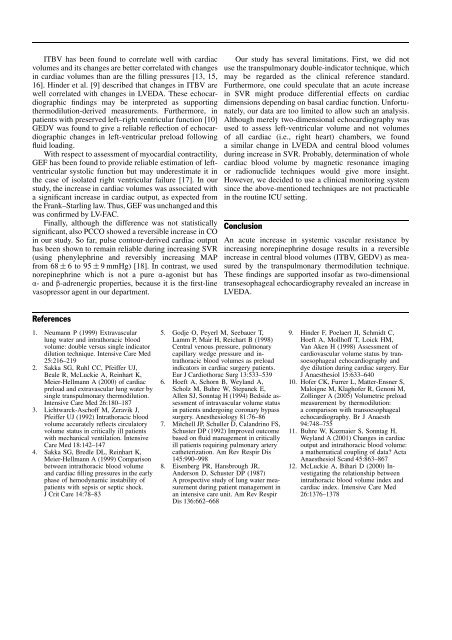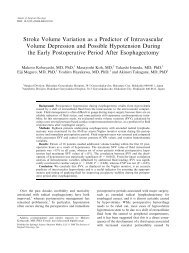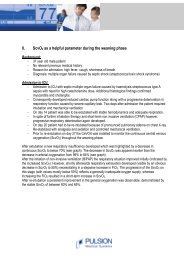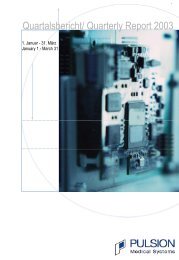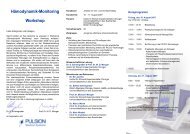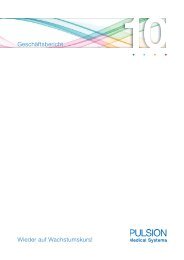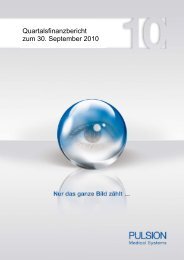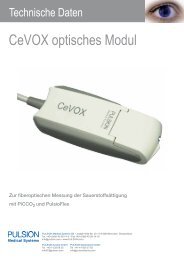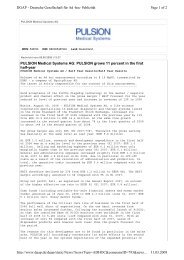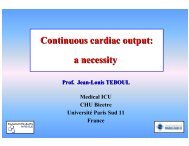View - PULSION Medical Systems SE
View - PULSION Medical Systems SE
View - PULSION Medical Systems SE
You also want an ePaper? Increase the reach of your titles
YUMPU automatically turns print PDFs into web optimized ePapers that Google loves.
ITBV has been found to correlate well with cardiac<br />
volumes and its changes are better correlated with changes<br />
in cardiac volumes than are the filling pressures [13, 15,<br />
16]. Hinder et al. [9] described that changes in ITBV are<br />
well correlated with changes in LVEDA. These echocardiographic<br />
findings may be interpreted as supporting<br />
thermodilution-derived measurements. Furthermore, in<br />
patients with preserved left–right ventricular function [10]<br />
GEDV was found to give a reliable reflection of echocardiographic<br />
changes in left-ventricular preload following<br />
fluid loading.<br />
With respect to assessment of myocardial contractility,<br />
GEF has been found to provide reliable estimation of leftventricular<br />
systolic function but may underestimate it in<br />
the case of isolated right ventricular failure [17]. In our<br />
study, the increase in cardiac volumes was associated with<br />
a significant increase in cardiac output, as expected from<br />
the Frank–Starling law. Thus, GEF was unchanged and this<br />
was confirmed by LV-FAC.<br />
Finally, although the difference was not statistically<br />
significant, also PCCO showed a reversible increase in CO<br />
in our study. So far, pulse contour-derived cardiac output<br />
has been shown to remain reliable during increasing SVR<br />
(using phenylephrine and reversibly increasing MAP<br />
from 68 ± 6to95± 9 mmHg) [18]. In contrast, we used<br />
norepinephrine which is not a pure α-agonist but has<br />
α- andβ-adrenergic properties, because it is the first-line<br />
vasopressor agent in our department.<br />
References<br />
1. Neumann P (1999) Extravascular<br />
lung water and intrathoracic blood<br />
volume: double versus single indicator<br />
dilution technique. Intensive Care Med<br />
25:216–219<br />
2. Sakka SG, Ruhl CC, Pfeiffer UJ,<br />
Beale R, McLuckie A, Reinhart K,<br />
Meier-Hellmann A (2000) of cardiac<br />
preload and extravascular lung water by<br />
single transpulmonary thermodilution.<br />
Intensive Care Med 26:180–187<br />
3. Lichtwarck-Aschoff M, Zeravik J,<br />
Pfeiffer UJ (1992) Intrathoracic blood<br />
volume accurately reflects circulatory<br />
volume status in critically ill patients<br />
with mechanical ventilation. Intensive<br />
Care Med 18:142–147<br />
4. Sakka SG, Bredle DL, Reinhart K,<br />
Meier-Hellmann A (1999) Comparison<br />
between intrathoracic blood volume<br />
and cardiac filling pressures in the early<br />
phase of hemodynamic instability of<br />
patients with sepsis or septic shock.<br />
J Crit Care 14:78–83<br />
Our study has several limitations. First, we did not<br />
use the transpulmonary double-indicator technique, which<br />
may be regarded as the clinical reference standard.<br />
Furthermore, one could speculate that an acute increase<br />
in SVR might produce differential effects on cardiac<br />
dimensions depending on basal cardiac function. Unfortunately,<br />
our data are too limited to allow such an analysis.<br />
Although merely two-dimensional echocardiography was<br />
used to assess left-ventricular volume and not volumes<br />
of all cardiac (i.e., right heart) chambers, we found<br />
a similar change in LVEDA and central blood volumes<br />
during increase in SVR. Probably, determination of whole<br />
cardiac blood volume by magnetic resonance imaging<br />
or radionuclide techniques would give more insight.<br />
However, we decided to use a clinical monitoring system<br />
since the above-mentioned techniques are not practicable<br />
in the routine ICU setting.<br />
Conclusion<br />
5. Godje O, Peyerl M, Seebauer T,<br />
Lamm P, Mair H, Reichart B (1998)<br />
Central venous pressure, pulmonary<br />
capillary wedge pressure and intrathoracic<br />
blood volumes as preload<br />
indicators in cardiac surgery patients.<br />
Eur J Cardiothorac Surg 13:533–539<br />
6. Hoeft A, Schorn B, Weyland A,<br />
Scholz M, Buhre W, Stepanek E,<br />
Allen SJ, Sonntag H (1994) Bedside assessment<br />
of intravascular volume status<br />
in patients undergoing coronary bypass<br />
surgery. Anesthesiology 81:76–86<br />
7. Mitchell JP, Schuller D, Calandrino FS,<br />
Schuster DP (1992) Improved outcome<br />
based on fluid management in critically<br />
ill patients requiring pulmonary artery<br />
catheterization. Am Rev Respir Dis<br />
145:990–998<br />
8. Eisenberg PR, Hansbrough JR,<br />
Anderson D, Schuster DP (1987)<br />
A prospective study of lung water measurement<br />
during patient management in<br />
an intensive care unit. Am Rev Respir<br />
Dis 136:662–668<br />
An acute increase in systemic vascular resistance by<br />
increasing norepinephrine dosage results in a reversible<br />
increase in central blood volumes (ITBV, GEDV) as measured<br />
by the transpulmonary thermodilution technique.<br />
These findings are supported insofar as two-dimensional<br />
transesophageal echocardiography revealed an increase in<br />
LVEDA.<br />
9. Hinder F, Poelaert JI, Schmidt C,<br />
Hoeft A, Mollhoff T, Loick HM,<br />
Van Aken H (1998) Assessment of<br />
cardiovascular volume status by transoesophageal<br />
echocardiography and<br />
dye dilution during cardiac surgery. Eur<br />
J Anaesthesiol 15:633–640<br />
10. Hofer CK, Furrer L, Matter-Ensner S,<br />
Maloigne M, Klaghofer R, Genoni M,<br />
Zollinger A (2005) Volumetric preload<br />
measurement by thermodilution:<br />
a comparison with transoesophageal<br />
echocardiography. Br J Anaesth<br />
94:748–755<br />
11. Buhre W, Kazmaier S, Sonntag H,<br />
Weyland A (2001) Changes in cardiac<br />
output and intrathoracic blood volume:<br />
a mathematical coupling of data? Acta<br />
Anaesthesiol Scand 45:863–867<br />
12. McLuckie A, Bihari D (2000) Investigating<br />
the relationship between<br />
intrathoracic blood volume index and<br />
cardiac index. Intensive Care Med<br />
26:1376–1378


